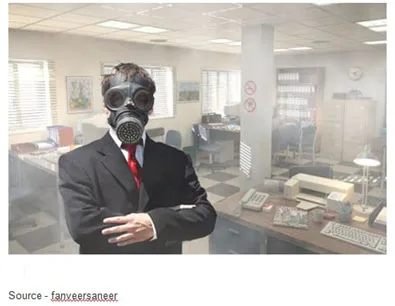Business Action – Accent the Positive, Eliminate the Negative
 You’ve probably read about the best places to work and wish you worked there.
You’ve probably read about the best places to work and wish you worked there.
You’ve also read some of those people really aren’t happy to go to work this morning.
They can’t both be right.
Maybe it’s not the place where you work but the people you work with … O.K., not all of them, just a few or maybe just one.
You know the one who is toxic as in poisonous, dangerous, contaminating, lethal.
Like a virus, he/she spreads counterproductive attitudes and actions that impact workgroups and the organization. Their contrarian, antagonistic approach spreads insidiously throughout the organization or people take extra steps to avoid becoming infected by ignoring, staying as far away as possible or limiting contact with the individual.
Toxic employees work very hard – and loud – to get their own way and will go to any length to protect their decisions, actions and territory, regardless of corporate goals or consensus. They’re oblivious to other’s inputs/recommendations and dismiss others’ ideas/thoughts/reasoning.
Any Length
They go to extraordinary lengths to belittle, denigrate, dismiss the suggestions or achievements of others, thus protecting their personal gains/territory. They can bully, throw a tantrum and hold their breath with the best four-year-olds.
Left unchecked, the toxicity can impair productivity and morale; increase arguments/confrontations and vocalized or unsaid frustrations that “things just aren’t going right” (their way). In the broader view, the toxicity discourages others to do whatever it takes to make a project, program succeed.
When you know you have a toxic employee, you can do nothing but hope the situation corrects itself and it just might happen. But most of the time, it doesn’t get better. In fact, the illness gets worse and may even spread.
For most executives, the issue is difficult to address because there are other, more pressing product, program, business relationship issues to handle. In addition, it’s difficult and often uncomfortable to confront a person’s behavioral issues than let’s say his/her substance abuse problems.
It Could Spread
But it has to be addressed for the well-being of other employees and the entire organization.
Before confronting the infected individual, validate the hearsay and assumptions just as a physician would … get all of the facts and get a second/third opinion.
Meet with the employee in a neutral office or offsite and focus on having a positive discussion, not an argument or confrontation.
It’s important to get his/her version of the situation.
Discuss the situation in generally positive and productive terms regarding potential problems that have been brought to your attention so it won’t result in a negative or unproductive outcome.
Give the employee all of the time necessary to explain his/her views of the situations, relationships and other areas in question.
Try to reconcile and reach a common understanding regarding how you and others view the toxic actions.
Keep in mind, your goal is to help the individual be an even more productive part of the team. The company has spent a lot of time and money in developing the employee and the best scenario is to get him/her to once again become a healthy member of the team.
He/she has to believe it.
Patient Zero
Patient zero may refuse to believe your interpretation but decide it is in the organization’s and his/her best interest to make a behavior/attitude change to meet your expectations.
If the individual doesn’t change, then you will have to begin official warning procedures or terminate the individual for the good of the organization.
The time-worn adage is true, “People are hired for their talents and fired for their behavior”
Remember, team members who were subjected to the abuse will probably require support so they can help you reestablish a healthy work environment.
Why is it important to address the issue head-on?
Also remember that toxic employees who seem to thrive on a negative perspective not only mistreat fellow employees but also business partners and customers.
What you really want is a closely knit team of highly motivated, experienced men and women who work together to have a motivated, high-performance organization that delivers the best possible products backed by superior customer service/support.
Or, maybe the toxic virus won’t spread … maybe.

